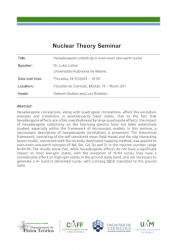Hexadecapole correlations, along with quadrupole correlations, affect the excitation energies and transitions in positive-parity band states. Due to the fact that hexadecapole effects are often overshadowed by large quadrupole effects, the impact of hexadecapole collectivity on the low-lying spectra have not been extensively studied, especially within the framework of microscopic models. In this seminar, a microscopic description of hexadecapole correlations is presented. The theoretical framework, consisting of the self-consistent mean field model and the sdg interacting boson model, connected with the recently developed mapping method, was applied to even-even rare-earth isotopes of Nd, Sm, Gd, Dy and Er in the neutron number range N=84-96. The results show that, while hexadecapole effects do not have a significant impact on most low-spin states, with the exception of N=84 nuclei, they have a considerable effect on high-spin states in the ground state band, and are necessary to generate a 4+ band in deformed nuclei, with a strong B(E4) transition to the ground state.

